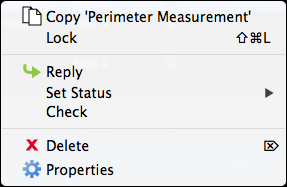The Markups list toolbar contains tools for organizing, processing, importing, and exporting data.

![]() Expand All and
Expand All and  Collapse All: Expands or collapses the entire list.
Collapse All: Expands or collapses the entire list.
 Previous and
Previous and
 Next: Moves to the previous or next markup in the list.
Next: Moves to the previous or next markup in the list.
![]() Filter and
Filter and  Clear Filters: Toggles column filters on and off and clears previously applied filters.
Clear Filters: Toggles column filters on and off and clears previously applied filters.
![]() Hide Markups: Hides all markups in the current PDF file. Markups will not be shown or printed when this mode is enabled. This mode is temporary and will be reset the next time Revu is started.
Hide Markups: Hides all markups in the current PDF file. Markups will not be shown or printed when this mode is enabled. This mode is temporary and will be reset the next time Revu is started.
Search: Filters the Markups list based on the text entered in the field.
![]() Columns: Selects which columns are shown in the Markups list.
Columns: Selects which columns are shown in the Markups list.
![]()
![]() Delete: Deletes a selected reply from the Markups list or a selected markup from both the PDF and the list.
Delete: Deletes a selected reply from the Markups list or a selected markup from both the PDF and the list.
![]() Reply: Replies to the selected markup. Replies appear on a new indented row below the markup in question.
Reply: Replies to the selected markup. Replies appear on a new indented row below the markup in question.
![]() Status: Sets the status of the markups. The Review statuses are Accepted, Rejected, Completed, Cancelled and None.
Status: Sets the status of the markups. The Review statuses are Accepted, Rejected, Completed, Cancelled and None.
![]() Checkmark: Checks or unchecks the checkbox associated with the selected markup. Also provides a command to clear all checkboxes.
Checkmark: Checks or unchecks the checkbox associated with the selected markup. Also provides a command to clear all checkboxes.
![]() Import: Takes the markups from a PDF, BAXThe BAX format is a Bluebeam-specific XML file. BAX files have the advantage of being able to be imported automatically by double-clicking them. If necessary, the .bax extension can be manually renamed to .xml to convert the file to a normal XML file. or an XML file and includes them in the active PDF (this is useful for incorporating and reviewing markups or feedback from multiple sources). FDF files containing annotations generated from other PDF applications may also be imported.
Import: Takes the markups from a PDF, BAXThe BAX format is a Bluebeam-specific XML file. BAX files have the advantage of being able to be imported automatically by double-clicking them. If necessary, the .bax extension can be manually renamed to .xml to convert the file to a normal XML file. or an XML file and includes them in the active PDF (this is useful for incorporating and reviewing markups or feedback from multiple sources). FDF files containing annotations generated from other PDF applications may also be imported.
![]() Export: Exports all markups to a BAXThe BAX format is a Bluebeam-specific XML file. BAX files have the advantage of being able to be imported automatically by double-clicking them. If necessary, the .bax extension can be manually renamed to .xml to convert the file to a normal XML file. or FDF file. The BAX file can be imported into another PDF so that the markups will be shown in the target PDF. The BAX file can also be imported into Excel. Markups can also be exported to the FDF format for interoperability with other PDF applications.
Export: Exports all markups to a BAXThe BAX format is a Bluebeam-specific XML file. BAX files have the advantage of being able to be imported automatically by double-clicking them. If necessary, the .bax extension can be manually renamed to .xml to convert the file to a normal XML file. or FDF file. The BAX file can be imported into another PDF so that the markups will be shown in the target PDF. The BAX file can also be imported into Excel. Markups can also be exported to the FDF format for interoperability with other PDF applications.
![]() Summary: Publishes a summary report of all the markups in a PDF
Summary: Publishes a summary report of all the markups in a PDF
 Subject: Shows both an icon and text that indicate the type of markup used on the PDF. This text can be changed in the Subject field in the Properties tab, or by double-clicking on the Subject text in the Markups list.
Subject: Shows both an icon and text that indicate the type of markup used on the PDF. This text can be changed in the Subject field in the Properties tab, or by double-clicking on the Subject text in the Markups list.  Copy stores the contents of the specific cell that was
Copy stores the contents of the specific cell that was